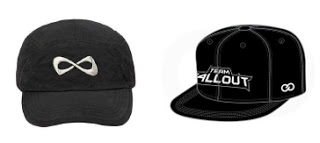Nfinity IP opposed Wooter,LLC's application to register the design mark shown below left, for various clothing items and sports bags, claiming a likelihood of confusion with its registered mark shown below right, for overlapping goods. Since the goods are, in part, identical, the Board presumed that those goods travel in the same, normal channels of trade to the same classes of consumers. Although the goods are sold to ordinary consumers and are not limited to price point, the Board found this factor be neutral. [Not sure why - ed.]. But what about the marks? That's the crux of the matter. How do you think this came out? Nfinity IP, LLC v. Wooter, LLC, Opposition No. 91241564 (March 9, 2021) [not precedential] (Opinion by Judge Linda A. Kuczma).

Strength of the Cited Mark: Opposer Nfinity did not provide evidence of its sales figures or marketing expenditures, nor any market share analysis. Nonetheless, its evidence regarding sales efforts and sponsorship of cheerleading tournaments, and the fact that the mark is inherently distinctive, led the Board to conclude that Nfinity's mark is "reasonably strong commercially."
Similarity of the Marks: "[S]imilarity in appearance between marks is really nothing more than a subjective 'eyeball' test. Because a picture is worth a thousand words, there is little in the way of guidelines to determine that degree of visual similarity which will cause a likelihood of confusion of buyers." J. Thomas McCarthy, 4 McCarthy on Trademarks and Unfair Competition § 23:25 (5th ed. 2020).
The Board observed that Opposer Nfinity's mark, which Nfinity calls its "'Infinity' trademark," has the appearance of a stylized "infinity" symbol, i.e., a figure-eight on its side. The "infinity" symbol overlaps in the middle to complete the figure eight. On the other hand, Applicant Wooter's mark has the appearance of two circles that open up into one another. Nfinity's mark has a three-dimensional quality, whereas Wooter's mark seems two-dimensional and flat.
Opposer's mark features a stylized infinity symbol, while Applicant's mark features a stylized depiction of a design which does not convey the same impression as Opposer's mark. Apart from the fact that both marks feature two lobes, the marks contain different elements, including lobes of different shapes and configurations.
The Board concluded that, although there is a "general similarity" between the marks, the similarity is outweighed by the differences. "When viewed in their entireties, the designs of Opposer's and Applicant's marks are clearly distinct in overall appearance such that they create different overall commercial impressions on purchasers."
The Sixth DuPont Factor: Wooter submitted nineteen third-party use-based registrations for marks that include an "infinity loop" symbol, covering the same goods, or related goods, to those listed in Nfinity's registrations. However, there was no evidence regarding use of these marks, and so the third-party registrations were entitled to "very little weight." "The fact that there are a number of registered marks containing an infinity design does not reflect a crowded marketplace, nor is it evidence of descriptiveness."
Conclusion: The Board concluded that the first DuPont factor - i.e., the dissimilarity of the marks - was dispositive, and so it dismissed the opposition.

Read comments and post your comment here.
TTABlogger comment: To me, Nfinity's mark looks more like a mobius strip than an infinity symbol.
The content of this article is intended to provide a general guide to the subject matter. Specialist advice should be sought about your specific circumstances.

